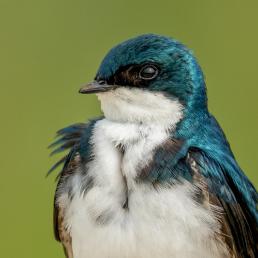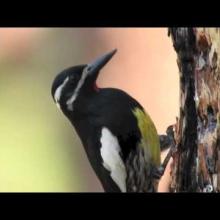

Join BirdNote tomorrow, November 30th!
Illustrator David Sibley and actor H. Jon Benjamin will face off in the bird illustration battle of the century during BirdNote's Year-end Celebration and Auction!
Williamson's Sapsuckers nest in western mountain forests. The radically different plumages of the male and female so confounded 19th-century naturalists that, for nearly a decade, the birds were thought to be of different species. Sapsuckers are unique among woodpeckers in drilling neat rows of tiny holes - or sapwells - in the trunks of trees. The sap provides food for the sapsuckers and snags small insects that are eaten by hummingbirds and warblers.
BirdNote®
Williamson’s Sapsucker: How Two Species Became One
Written by Bob Sundstrom
BirdNote®
Williamson’s Sapsucker: How Two Species Became One
Written by Bob Sundstrom
This is BirdNote!
[Williamson’s Sapsucker rhythmic drumming]
Two robin-sized woodpeckers ascend the same massive pine trunk. The first woodpecker is tawny brown and cryptically patterned, the second is glistening black, boldly accented with white, yellow and red. The two couldn’t look more mismatched.
[Williamson’s Sapsucker foraging and vocalizing]
But this is a mated pair of Williamson’s Sapsuckers, a migratory species that nests in the mountain forests throughout much of the West.
[Williamson’s Sapsuckers vocalizing]
Their radically different plumages so confounded 19th-century naturalists that, for nearly a decade, the birds were put down in the books as different species! Williamson’s Sapsuckers share Western forests with a dozen species of woodpeckers. Yet Sapsuckers are unique among woodpeckers in drilling neat rows of tiny holes in the trunks of trees.
[Williamson’s Sapsucker foraging]
Sap oozes very slowly from the holes. A food for the sapsuckers, the sap also acts like flypaper, snagging small insects collected by foraging hummingbirds and warblers.
The conservation success of Williamson’s Sapsucker requires well-informed forest management. By allowing low-intensity fires to create opens stands of large conifers and by preserving clusters of old aspen snags, land managers can help create ideal nest trees for Williamson’s Sapsuckers.
The West wouldn’t be the same without them.
[Williamson’s Sapsuckers vocalizing]
For BirdNote, I’m Michael Stein.
###
Bird sounds provided by The Macaulay Library of Natural Sounds at the Cornell Lab of Ornithology, Ithaca, New York. Drumming of Williamson’s Sapsucker [47585_425] recorded by D.S. Herr; foraging and vocalizing [56927] recorded by G.A. Keller.
BirdNote’s theme music was composed and played by Nancy Rumbel and John Kessler.
Producer: John Kessler
Executive Producer: Chris Peterson
© 2013 Tune In to Nature.org May 2013 Narrator: Michael Stein
ID# 042606WISAKPLUWISA-01b





